| |
Richard Barbieri interview February 2005 Tokyo Japan: |
| |
 |
 |
What was your impression when you used Roland synthesizers for the first time? |
 |
|
| |
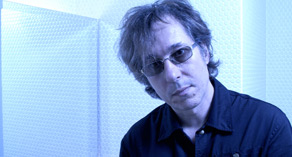 I first used them when I was 17 and a half, and my first synthesizer was a Roland System-700 (A vintage full scale modular synthesizer series). It was a kind of different one, it was a Laboratory-Series which is quite rare. I got it home and obviously it made no sound so I had to learn about how to use a synthesizer. It was a very good education for me, because if I had to make sounds I had to find out how everything worked. I first used them when I was 17 and a half, and my first synthesizer was a Roland System-700 (A vintage full scale modular synthesizer series). It was a kind of different one, it was a Laboratory-Series which is quite rare. I got it home and obviously it made no sound so I had to learn about how to use a synthesizer. It was a very good education for me, because if I had to make sounds I had to find out how everything worked.
By time I was 18 or 19, I already had some really good experiences with synthesizers, so I began to understand. |
| |
 |
 |
Before you joined the band "Japan" what synthesizers were you using? |
 |
|
 |
Nothing when I joined the band, because the group was formed on friendship we decided to start the band and then we started to use instruments. I had a kind of toy almost, a Crumar, do you remember that one ? Just maybe with three sounds including electric piano.
But I couldn't play really well. At that time I liked a lot of bands like Genesis, Yes, Emerson Lake and Palmer, but I knew I couldn't be like those keyboard players. So I had to work with sounds and a more abstract approach. Synthesizers were the answer for me. Synthesizers and Brian Eno were the answer, because Brian Eno was a non musician. When I heard what he did in Roxy Music, I knew that there were possibilities to do something interesting in Pop Music. |
| |
 |
 |
After you joined "Japan" which instruments did you have? |
 |
|
| |
I used the System-700, a Wurlitzer EP-200, a Solina Strings Synthesizer, and later I added a MicroMoog. I put the synthesizers through Roland Space Echos. That was my first "professional" set-up. |
| |
 |
 |
After System-700 and before V-Synth did you use any other Roland gears? |
 |
|
| |
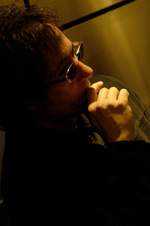 Yes, D-50, very important for me. At first I found it very difficult, but when I bought the Programmer PG-1000 then I could work really quickly, I managed to create quite different sounds. I used it for a very long time, all the way through the '80s and right until maybe two years ago. Yes, D-50, very important for me. At first I found it very difficult, but when I bought the Programmer PG-1000 then I could work really quickly, I managed to create quite different sounds. I used it for a very long time, all the way through the '80s and right until maybe two years ago.
After that I used a JV-2080 which I use on stage now because it's really good for live work and very flexible. I can have Performances and I can change from one set up to another really quickly, and it's very helpful in that respect. |
| |
 |
 |
Are you the type of keyboard player who try to use all the functions of a synthesizer you have? |
 |
|
| |
Yeah, yeah, I hope so (laughs), I spend a long time on sounds, hours and hours and hours. In today's culture that's unusual because people want something instant, they want it quickly to do something, but for me it's important to take the time and build up special sounds. |
| |
 |
 |
You use V-Synth quite a lot in your recent album "Things Buried". What is the good thing about V-Synth? |
 |
|
| |
What I like is the amount of control that you can have. For me it's all about sounds evolving, changing. V-Synth has many many possibility to change and to morph one sound to another sound, progress one sound from A to B. Just one note (plays a note G on V-Synth. Pad sound with soft and evolving texture and occasional pitch bending) and the sound is changing all the time, gives you a movement, an atmosphere and that for me is an important thing. I was never interested in, say an ordinary sax sound (plays a sax wave), never excited me. I need to create something that moves, something that has emotion. |
| |
 |
 |
Do you usually have a certain sound to start from? |
 |
|
| |
No, it always starts in my mind, I can hear something. It could be anything, it could be natural sounds, it could be rain or wind or it could be the ambient sounds of airports or Train stations, I just hear a tone or a kind of a sound that interests me and I start work to find, to get near to that sound. |
| |
 |
 |
How do you use analog modeling synthesis? |
 |
|
| |
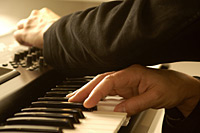 I use (Sequential Circuits) Prophet-5 and whatever synthesizer I play I do try to get certain favourite Prophet-5 sounds, which is a challenge for me. I use my lead sound in the Prophet quite a lot, which has an Arabian / Indian flavour and I've made a sound very similar to that on V-Synth. There is a kind of noise that the Prophet has and I tried to reproduce on this one (plays a soft evolving lead). That's pretty "Prophet". I use (Sequential Circuits) Prophet-5 and whatever synthesizer I play I do try to get certain favourite Prophet-5 sounds, which is a challenge for me. I use my lead sound in the Prophet quite a lot, which has an Arabian / Indian flavour and I've made a sound very similar to that on V-Synth. There is a kind of noise that the Prophet has and I tried to reproduce on this one (plays a soft evolving lead). That's pretty "Prophet".
With analog synthesizers you're working with very pure waveforms and ususally just two or three. So that is a challenge to the manufacturers of digital synthesizers to create this pure kind of waveform which sounds easy but isn't, because there are always discrepancies . For example, a pure waveform reacts differently with resonance (plays and tweaks) and modulation depending on the set up of the filtering section. |
| |
 |
 |
Do you have a theory to make sounds? |
 |
|
| |
Yes, there is a logic, and there are two ways to approach making sounds. You can do it exactly the right way or you can do it exactly the wrong way, and the wrong way is interesting as well.
Aphex Twin, the approach is completely wrong and he breaks all the rules and he breaks all the equipment as well or something (laughs), BUT he creates something that is unlike anyone else.
And the other way is to understand how to make sounds, to use waveforms, to use ring modulation, to use effects, to use filtering, to find sounds. So you will play something smooth and something very nice, but we can also get quite interesting sounds. (Plays a ring modulator sweep swirling at will) Now that I wanted to sound like a radio, searching through the bandwidth, but I also wanted something dark and scary and vaguely musical. |
| |
 |
 |
Do you find anything special on V-Synth? |
 |
|
| |
Yes, you can take processing further. You can ring modulate something but then you have COSM, so you can use, for example, a SideBand Filter which kind of picks up the harmonics of the sound so it's like a further ring modulation, like a second stage ring modulation. You also have a virtual modeling of instruments, with microphone positioning. So it's possible to take sound transformation through three or four stages of processing before you reach normal kind of modulation or filtering. Lo-Fi processors, Polyphonic Frequency Shifters, Step Modulation, SideBand Filters, various Amp simulators, and three kinds of effects sections, so you can go on and on and produce a more complex texture if you want. You just have to understand the path to get from A to B. |
| |
 |
 |
What kind of sounds represent your originality? |
 |
|
| |
I can't describe it. I work on different kinds of musics, I'm in a rock band called Porcupine Tree, it's experimental / progressive rock, I also play with some jazz projects, I play with an improvisational ambient / electronic group, and I have same approach on all of them really. I try to find the right space and introduce my own "voice" or personality into the music. I think when people hear my kind of sounds, they just hear something a little bit strange, or a little bit abstract.
If you listen to a rock band like Deep Purple they are fantastic, John Lord is brilliant, but you know what he is doing, what his sound is, Hammond with distortion, it's the classic approach in rock music. My approach would be something stranger and more abstract. It's like the "Japan" material on an album called "Tin Drum". We were playing almost imitations of acoustic instruments from from Asia and the Far East, but using synthesizers. There is something a little bit strange about it, and this is what makes people think "That's an interesting sound". Because it's an impression of something else. A distortion of reality if you like. |
| |
 |
 |
The total sound of the album "Things Buried" is clear and transparent but synthesized, distorted, which is similar to what you have just said. |
 |
|
| |
Yes, exactly.
The interesting thing about this album for me technically is that it is completely digital.
It's the first time I've ever made a recording with no analog synthesizers. Because I've been using analog synthesizers for 25 years, I became so comfortable with it, that I wanted a new challenge. You know sometimes if you became too comfortable with something it becomes too easy, so the challenge to me was to make digital sound warm. (Drags a chair) That's a new sound (Everybody laughs). |
| |
 |
 |
Do you use VariPhrase on V-Synth a lot? |
 |
|
| |
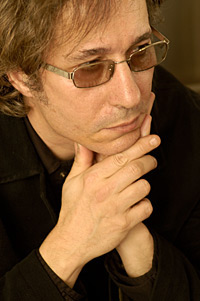 Yeah! I use them on some of the sounds I play. It's interesting to change the formant and the pitch of a wave, and make that move. So the very first sound that I played was a voice, but changing with formant, so it gives a very kind of expressive movement to the sound. Yeah! I use them on some of the sounds I play. It's interesting to change the formant and the pitch of a wave, and make that move. So the very first sound that I played was a voice, but changing with formant, so it gives a very kind of expressive movement to the sound.
Also important is that you can sample your own waveforms. So you can create. You don't have to use what's in here. I have a guitarist friend from Pakistan (Aziz Ibrahim). I sampled his guitar (plays a phrase sample), and I changed the formant and reversed it (plays and twists), which is a nice waveform you can have with another sound.
Or also you can take a normal kind of like voices that I found in the V-Synth, just a kind of basic voice sound but you can start to change the pitch and formant to produce something quite strange. This is kind of inspired by Stockhausen. I'm a big fan of Stockhausen's early works and he uses voices in an interesting way (plays a short tune with moaning sound).
Also I never gave my sounds to anyone else before, but the last few years I started let people have my sounds, because I realized finally that it doesn't matter if they have them because they won't play it the same. I realized it's not the sound but what you do with the sound. |
| |
|
| |
I do a little, and maybe I'll do a lot more. It's possible to get so many different kind of things. There are a lot of musicians that I love, trumpet players, guitarists, they have very particular sounds, and it would be nice to use some of those as a waveform and create sounds from that. With their permission of course. |
| |
|
| |
Yes, fantastic, because it feels more human and physical. You're not just pressing a little bit of a plastic. With so many positions, with your hands and with your voice (plays a vocal wave with ethnic pitch intonations) it feels like I'm interacting. It's different. |
| |
 |
 |
Which parameters do you assign to D Beam? |
 |
|
| |
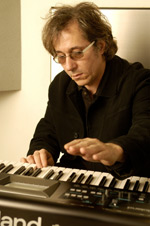 Different every time. Sometimes just simple pitch, other times to reverse the sound, other times filter on one side may be a modulation on the other side. Different every time. Sometimes just simple pitch, other times to reverse the sound, other times filter on one side may be a modulation on the other side.
Also you'll have to become quite skilled. It's like a Theremin. Theremin is the most difficult instrument to play, but there is one woman who can play the Theremin amazingly, it's like a cello, and she is very famous. |
| |
|
| |
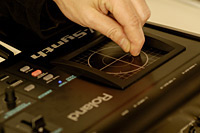 TimeTrip Pad as well (plays like an ethnic violin phrase on E minor key). It's doing a bit of everything, you can go on a circle, you can go backwards, you can set up a tempo you want for the music you're playing (sound freezes and wiggles around in low E major key). TimeTrip Pad as well (plays like an ethnic violin phrase on E minor key). It's doing a bit of everything, you can go on a circle, you can go backwards, you can set up a tempo you want for the music you're playing (sound freezes and wiggles around in low E major key). |
| |
 |
 |
You use that kind of sound quite often. |
 |
|
| |
I do. I'm a frustrated guitarist, I compete with guitars because they are always too loud (laughs).
I'm also very influenced by Robert Fripp. He is my favorite guitarist, and I like his sounds, very keyboard-like. He will be opening the show for Porcupine Tree on our next tour, so I'm excited about that. |
| |
 |
 |
You mentioned that D-50 was important for you. Have you tried the VC-1 D-50 card for V-Synth and VariOS? |
 |
|
| |
I know. I wish I knew about it before, because I have three D-50's at home (laughs). I've been buying them, and then I didn't want too much on stage because I needed more room, so I bought D-550 which is a rack, and now it's a card ! |
| |
 |
 |
Have you tried the VC-2 Vocal Designer card? |
 |
|
| |
I did a little bit on stage, it's very new to me and I'm not a singer so I'm just beginning to find things to do with my voice, but two things seem most natural for me to do now, which is very new.
One is more like a choral, like a backing voice for my music which is great to hear, because what I'm singing is rubbish but what is coming out is fantastic, well sort of !
The other thing is a kind of percussive approach, with the voice, which is quite an interesting effect because it picks up every kind of inflection. You can really define the sounds. |
| |
 |
 |
Besides these sustained sounds, you also use percussions on your album. |
 |
|
| |
Yes, I use both. I used a lot of electronic percussion when I started programming the album, but also the drummer that I used likes to play electronic pads as well, he plays an acoustic kit but he's also into electronic drumming. It sounded good with the things I did as well. It seemed to have a same kind of sound. I like to use electronic percussion, and I also wanted the human feel, excitement, musicians playing together, different mentality, energy. Programming percussion is of the mind, and playing is something physical, spiritual even. |
| |
 |
 |
In your recent work "Things Buried" is there any sound that respresent the characteristic of V-Synth? |
 |
|
| |
There are a lot of lead sounds that I use, and there is a kind of ethnic approach to sound that we used on "Tin Drum" a lot (plays a slow percussion phrase with rich soft sounding metallic overtone). So there were a lot of Cross Modulation sounds. Again it makes you think of acoustic instruments but I don't know which one. It's just the feeling of something being played (plays). |
| |
 |
 |
Have you tried the V-Synth XT? |
 |
|
| |
I tried with a microphone, I used it on stage, a little V-Synth with new software improved and with extras like D-50 card pre-installed. |
| |
 |
 |
Lastly, what are your plans from now? |
 |
|
| |
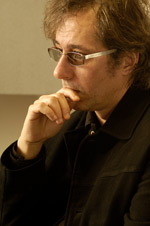 I'm very busy, the group that I'm in called Porcupine Tree and we recently released a new album for Warner Brothers, so I have two months of touring now but after I have a month break, so I'm going to do a different tour with a group in UK. It's an electronic group that improvises called The Bays. The drummer, Andy Gangadeen played on my album. In England, Jeff Beck is playing the guitar with us so that's going to be interesting. I'm very busy, the group that I'm in called Porcupine Tree and we recently released a new album for Warner Brothers, so I have two months of touring now but after I have a month break, so I'm going to do a different tour with a group in UK. It's an electronic group that improvises called The Bays. The drummer, Andy Gangadeen played on my album. In England, Jeff Beck is playing the guitar with us so that's going to be interesting.
So that's two and a half months I'll be on the road, and then maybe I'll end up divorced (laughs), hopefully I'll come back to Japan later to do a solo tour, after the divorce (Everybody big laughs). |
| |
 |
 |
Thank you very much. Hope you won't get divorced (laughs). |
 |
|
| |
Thank you, it's a long time we are away, but don't worry. :) |
| |
|
| |
|
| |
|
 |
|
 |
 |

